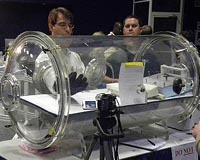 |
Bethesda MD (SPX) Nov 23, 2009 Launch vehicle prices are sky high and they have been for a long time. This has presented a very high hurdle to space access for many potential space applications. There are literally tens of thousands of university experiments awaiting flight opportunities, but the cost is too high for students and faculty. Hundreds of private-sector entrepreneurs have waited years for a chance to try new ideas and applications. Even large, established companies would like to stretch product lines through space experimentation, but have been frustrated by the high cost of launching trial products. The promise of reusable space launch systems is dramatically lower costs to orbit. An ideal, fully-reusable system would be highly reliable, readily available and could cut costs by a factor of 10 or more. The introduction of such a system would open space access to thousands of denied users. So, why don't we have one? There are several reasons. Technologies for fully-reusable orbital launch systems still evade the many companies that have attempted to design and build them. There is a large up-front investment needed to develop and test any new launch system and companies either cannot raise enough money or are unwilling to take the risks associated with investing the needed funds. The market for a reusable system is still immature, i.e., demand for launch services is in the embryonic stages, even though we have been launching satellites for over 50 years. Elusive technologies include truly reusable cryogenic tanks, low-maintenance thermal shielding, ultra-lightweight structures and advanced avionics. Financing such projects has been problematic, thanks to the many failures and overly-optimistic cost and revenue projections. However, these hurdles will be overcome as the market matures. The one missing ingredient that would truly make reusable vehicles come to life is a "killer application" that would create a strong market demand for low-Earth-orbit flights. There seem to be two possible business activities that might generate the needed market demand. One is the eventual human-tourism market that is just getting started with sub-orbital flights. The other is the creation of a large, distributed space infrastructure of low-orbiting satellites that must be maintained over a long period of time. There is little doubt that the day will come when reusable systems are indeed a reality. The only question is: How soon? If you want to know more about the design and technologies of launch vehicles register for a special session of the internationally popular course: Launch Vehicle Systems Design and Engineering, to be presented in Cocoa Beach on December 14-16, 2009. Share This Article With Planet Earth
Related Links Launchspace Space Tourism, Space Transport and Space Exploration News
 NASA Awards Winning Astronaut Glove Designers
NASA Awards Winning Astronaut Glove DesignersWashington DC (SPX) Nov 23, 2009 NASA's Centennial Challenges program awarded $350,000 this week to a pair of designers who developed concepts for more flexible space gloves that could make it easier for astronauts to perform tasks. The 2009 Astronaut Glove Challenge awarded a first place prize of $250,000 to Peter Homer of Southwest Harbor, Maine, and a second place prize of $100,000 to Ted Southern of Brooklyn, N.Y. ... read more |
|
| The content herein, unless otherwise known to be public domain, are Copyright 1995-2009 - SpaceDaily. AFP and UPI Wire Stories are copyright Agence France-Presse and United Press International. ESA Portal Reports are copyright European Space Agency. All NASA sourced material is public domain. Additional copyrights may apply in whole or part to other bona fide parties. Advertising does not imply endorsement,agreement or approval of any opinions, statements or information provided by SpaceDaily on any Web page published or hosted by SpaceDaily. Privacy Statement |